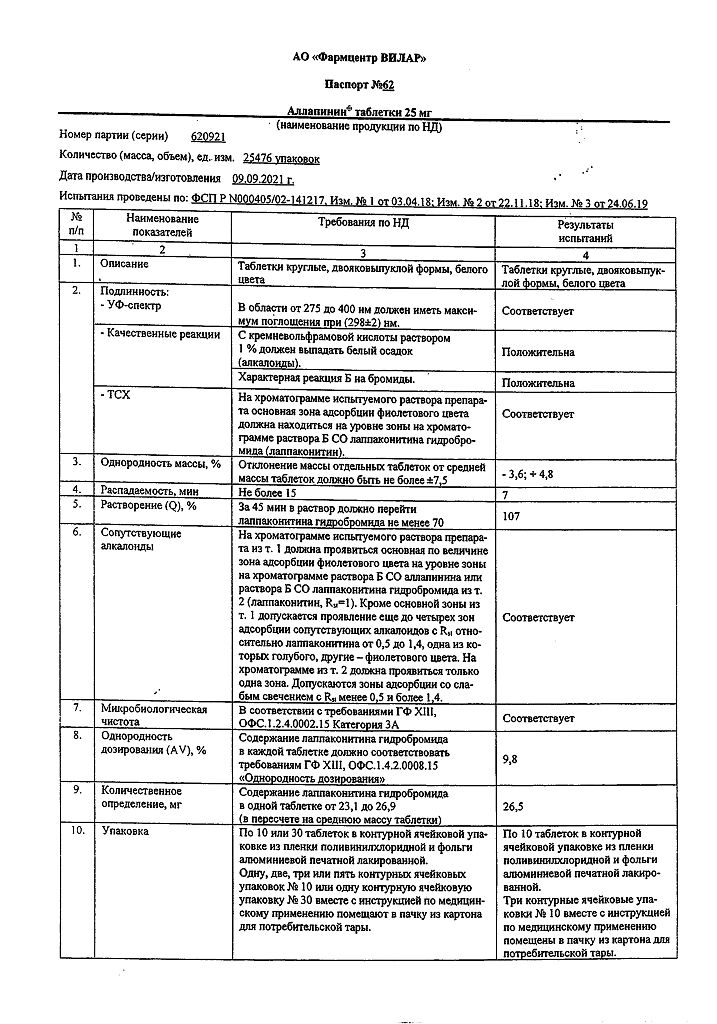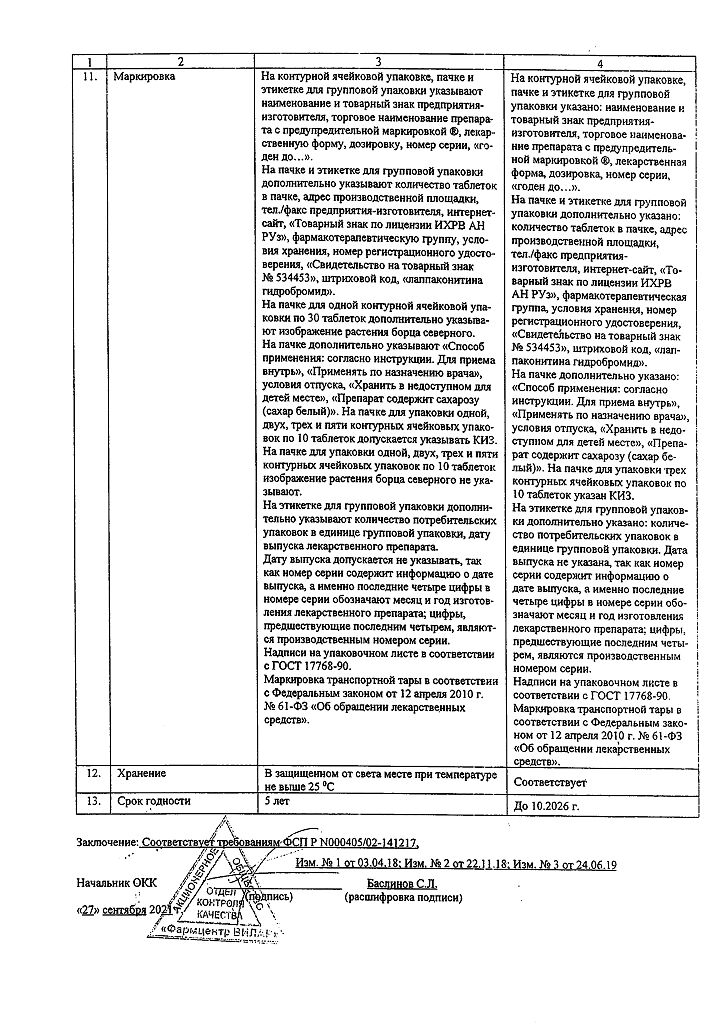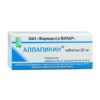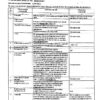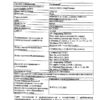No products in the cart.
Allapinin, tablets 25 mg 30 pcs
€17.25 €14.37
Description
Allapinin is a class I C antiarrhythmic drug. It blocks fast sodium channels of cardiomyocyte membranes. It causes delay in AV and intraventricular conduction, shortens effective and functional refractory periods of atria, AV node, Gis bundle and Purkinje fibers, does not influence QT interval duration, conduction along AV node in anterograde direction, HR, BP, myocardial contractility (in initial absence of cardiac insufficiency).
It does not inhibit sinus node automatism. It does not cause negative inotropic and hypotensive effect.
Allapinin® has moderate antispasmodic, coronary dilator, choline blocker, local anesthetic and sedative effects. When administered orally the effect occurs within 40-60 minutes and maximum effect is reached after 80 minutes and lasts for 8 hours and more.
Pharmacokinetics:
Eabsorption
Bioavailability is 40%. The drug is subjected to the effect of “first passage” through the liver.
Distribution and metabolism
When administered orally, Vd is 690 L. It penetrates through the BBB.
Excretion
T1/2 is 1-1.2 h. It is eliminated by the kidneys.
Pharmacokinetics in special clinical cases
In prolonged use, increased T1/2 is possible. In chronic renal failure T1/2 is increased by 2-3 times, in liver cirrhosis by 3-10 times.
Indications
Indications
– supraventricular extrasystole;
– ventricular extrasystole;
— paroxysms of atrial fibrillation and flutter;
— paroxysmal supraventricular tachycardia (including with WPW syndrome);
– paroxysmal ventricular tachycardia (in the absence of organic heart damage).
Pharmacological effect
Pharmacological effect
Allapinin is a class I C antiarrhythmic drug. It blocks fast sodium channels of cardiomyocyte membranes. Causes a slowdown of AV and intraventricular conduction, shortens the effective and functional refractory periods of the atria, AV node, His bundle and Purkinje fibers, does not affect the duration of the QT interval, conduction through the AV node in the anterograde direction, heart rate, blood pressure, myocardial contractility (in the initial absence of heart failure).
Does not inhibit the automatism of the sinus node. Does not cause negative inotropic and hypotensive effects.
Allapinin® has a moderate antispasmodic, coronary dilation, anticholinergic, local anesthetic and sedative effect. When taken orally, the effect develops after 40-60 minutes, reaches a maximum after 80 minutes and lasts 8 hours or more.
Pharmacokinetics:
Suction
Bioavailability is 40%. The drug undergoes a “first pass” effect through the liver.
Distribution and metabolism
When taken orally, Vd is 690 l. Penetrates through the BBB.
Removal
T1/2 is 1-1.2 hours. Excreted by the kidneys.
Pharmacokinetics in special clinical situations
With long-term use, an increase in T1/2 is possible. With chronic renal failure, T1/2 increases by 2-3 times, with liver cirrhosis – by 3-10 times.
Special instructions
Special instructions
Before starting to use the drug Allapinin®, it is necessary to eliminate disturbances in water-electrolyte metabolism; during therapy, monitoring of the water-electrolyte balance of water is necessary.
In patients who have suffered an acute myocardial infarction, or in patients with heart failure, as well as in patients with an installed artificial cardiac pacemaker, the pacemaker threshold may increase.
If headache, dizziness, or diplopia develop, the dose of Allapinin® should be reduced.
If sinus tachycardia occurs during long-term use of the drug, the use of beta-blockers in low doses is indicated.
1 tablet contains 74 mg of carbohydrates, which corresponds to 0.01 XE.
Impact on the ability to drive vehicles and operate machinery
When using the drug, care should be taken when performing potentially hazardous activities that require special attention and quick reactions (driving vehicles, working with moving mechanisms).
Active ingredient
Active ingredient
Lappaconitine hydrobromide
Composition
Composition
1 tablet contains:
Active substance:
allapinin – 25 mg;
Excipients:
sucrose (sugar),
potato starch,
calcium stearate (calcium stearate).
Contraindications
Contraindications
— sinoatrial blockade;
— AV blockade II and III degrees (without artificial pacemaker);
— cardiogenic shock;
– blockade of the right bundle branch, combined with a blockade of one of the branches of the left leg;
– severe arterial hypotension (systolic blood pressure less than 90 mm Hg);
– moderate and severe chronic heart failure of functional class III-IV according to the NYHA classification;
— pronounced hypertrophy of the left ventricular myocardium (≥1.4 cm);
— presence of post-infarction cardiosclerosis;
– severe impairment of liver and/or kidney function;
— fructose intolerance, glucose/galactose malabsorption syndrome, sucrase/isomaltase deficiency (the drug contains sucrose);
– children and adolescents under 18 years of age (efficacy and safety have not been established);
– hypersensitivity to the drug Allapinin.
The drug should be used with caution in case of 1st degree AV block, intraventricular conduction disorder, CVS, bradycardia, severe peripheral circulatory disorders, angle-closure glaucoma, prostatic hypertrophy, Purkinje fiber conduction disorder, blockade of one of the His bundle branches, electrolyte metabolism disorders (hypokalemia, hyperkalemia, hypomagnesemia), when taken simultaneously with other antiarrhythmic drugs.
Side Effects
Side Effects
From the central nervous system and peripheral nervous system: possible dizziness, headache, feeling of heaviness in the head, ataxia, diplopia.
From the cardiovascular system: possible disturbances of AV and intraventricular conduction, the appearance of sinus tachycardia (with long-term use), arrhythmogenic effects, changes in the ECG (extension of the PQ interval, expansion of the QRS complex).
Other: skin hyperemia and allergic reactions are possible.
Interaction
Interaction
When Allapinin is used simultaneously with inducers of microsomal liver enzymes, the effectiveness of lappaconitine hydrobromide is reduced and the risk of developing toxic effects increases.
Antiarrhythmic drugs of other classes increase the risk of developing arrhythmogenic effects.
Lappaconitine hydrobromide enhances the effect of non-depolarizing muscle relaxants.
Overdose
Overdose
Symptoms: the drug has a small breadth of therapeutic action, so severe intoxication can easily occur (especially with the simultaneous use of other antiarrhythmic drugs): prolongation of the PR and QT intervals, expansion of the QRS complex, increased amplitude of the T wave, bradycardia, sinoatrial block, AV block, asystole, paroxysms of polymorphic ventricular tachycardia, decreased myocardial contractility, marked decrease Blood pressure, dizziness, blurred vision, headache, gastrointestinal disorders.
Treatment: carry out symptomatic therapy.
For the treatment of ventricular tachycardia, antiarrhythmic drugs of class I A and I C should not be used. Sodium bicarbonate can eliminate the expansion of the QRS complex, bradycardia and arterial hypotension.
Storage conditions
Storage conditions
In a place protected from light.
Manufacturer
Manufacturer
Pharmcenter VILAR JSC, Russia
Additional information
| Conditions of storage | In a place protected from light. |
|---|---|
| Manufacturer | Pharmtsentr VILAR JSC, Russia |
| Medication form | pills |
| Brand | Pharmtsentr VILAR JSC |
Related products
Buy Allapinin, tablets 25 mg 30 pcs with delivery to USA, UK, Europe and over 120 other countries.


